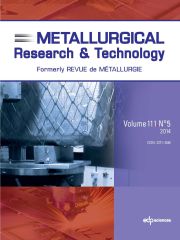Article contents
Study of uniform quenching technology of NM450 wear-resistantsteel
Published online by Cambridge University Press: 31 October 2013
Abstract
The finite difference method of the low-alloy wear-resistant steel quenching process wasstudied. The temperature field and cooling rate variation of thickness of 45-mmwear-resistant steel (NM450) were calculated for different quenching practices. Themicrostructure and hardness of quenched plates were examined. The results indicate thatwhen quenching started, the cooling rate was highest on the subsurface and decreasedgradually until the center of the plate. However, as the quenching progressed, the coolingrate distribution along the plate thickness was reversed. The cooling rate increasedlinearly when the heat transfer coefficient (HTC) increased from 0–10 000W/m2 K, and then the speed gradually slowed down until achieving the maximumcooling rate. Close to the plate mid-thickness, the maximum cooling rate was easilyreached. Compared with high-pressure (HP) quenching and low-pressure (LP) quenching, underthe HP + LP continuous quenching mode, it is possible to obtain a high critical coolingrate in the temperature range of 900 °C–400 °C and small temperature difference betweenthe surface and center below 400 °C. The microstructure and hardness distribution on theplate surface for the HP + LP quenching mode indicated 100% martensite on the surface andmartensite with a little granular bainite in the plate center, while the hardnessdifference in the entire steel plate was less than 7%. This study provided guidance forthe formulation and optimization of wear-resistant steel.
- Type
- Research Article
- Information
- Copyright
- © EDP Sciences 2013
References
- 1
- Cited by


